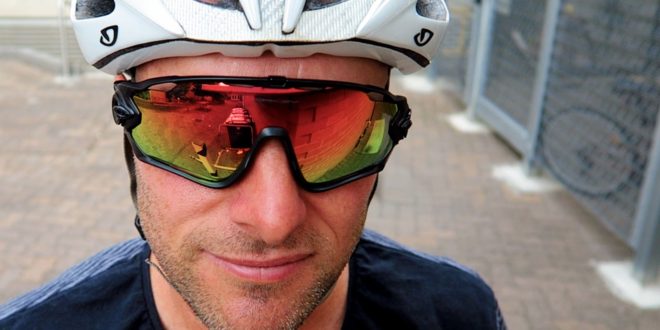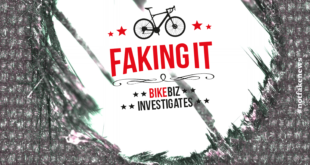Oakley Radarlock sunglasses retail for £175. An almost identical pair – but fake – can be bought online for £20, shipped. Fake Oakleys are so common they are known as “Foakleys,” a portmanteau of “faux” and “Oakley.”
Foakley is such an accepted word that websites openly sell “Foakley” glasses. For instance, sunglasses.narialis.com claims to be a US company with a US address, and sells Foakley Radarlocks for $13 – it has the Oakley logo at the top of the homepage but the word “Foakley” is all over the site, and it openly states that the glasses are knock-offs. Of course, the site isn’t really US-based: it ships via EMS, the Chinese state-owned courier firm.
But this is far from the only website selling Oakley knock-offs. There are Foakley sellers on Alibaba, DHgate, and other Chinese online merchants. A British cycle industry executive told BikeBiz that all of the riders in his cycling club who wore Oakley’s have, in fact, been wearing Foakleys for at least the past couple of years.
“Determining if they are real or counterfeit can be difficult,” admits Oakley on an official FAQ. Indeed, purchasers of fake Oakleys have found that the lenses and other parts are interchangeable with genuine Oakleys.
An often seen claim online is that the fakes fry eyes because, unlike expensive and genuine Oakleys, they let through ultra-violet radiation. This is not true. Fake Oaks have been lab-tested and found to block UV-A and UV-B.
Oakley lenses are made from polycarbonate, and so are the fake lenses. An intrinsic property of polycarbonate is that it blocks UV.
“I don’t want to pay what Oakley are charging; they’re just bits of plastic,” is a common complaint on cycle forums and chat-rooms.
People who wouldn’t buy fake bicycle frames or fake parts aren’t so fastidious when it comes to Foakleys, as can be seen from the interviews BikeBiz has conducted with three purchasers. Consumers feel they’re being “ripped off.”
Oakley is owned by the $9bn Luxottica Group of Italy, the world’s largest eyewear company. 81-year-old Leonardo Del Vecchio, the group’s founder, bestrides the sector like a Ray-Ban-wearing Colossus. (Luxottica also owns Ray-Ban.) The Guardian has a very good long-read on the £74bn specs biz, and Del Vecchio’s dominance.
Luxottica acquired Oakley for $2.1bn in 2007. The group also makes and distributes eyewear brands such as Chanel, Prada, Giorgio Armani, Burberry, and Versace. Luxottica doesn’t just dominate manufacturing and distribution it also dominates retail: it owns 7,000 stores around the world, including Sunglass Hut, the market leader.
When pre-takeover, Oakley was starved of access to Sunglass Hut its stock plummeted making the sale to Luxottica a foregone conclusion.
TAKEN FOR A RIDE
Mark Ferguson of Melbourne, Australia, is in surgical device sales. He vlogs as “CyclingMaven”. One of his most popular videos is on the technical merits of Foakleys.
“We pay a premium for a lot of things in Australia. My Oakleys, with lenses, were pushing nearly AU$600. I put them on a [bike storage] cage; within a few hours, they were gone.To replace them was going to be expensive. Somebody sent me a link at Aliexpress. My original thought was “no”; it didn’t feel right. But curiosity got the better of me, and I bought some. And the quality was shocking – I couldn’t believe how good they were. For $30.
“Are they made in the same factory as Oakleys? I don’t know, but a lot of people who buy these fakes will rationalise it that way. Not everybody feels comfortable buying counterfeit products.
“The anti-establishment side of me says, look, here’s a company selling bits of plastic for AU$500. In my mind, they’re ripping people off. I don’t care about the research and development. There’s always going to be somebody innovating. If Oakley were to disappear off the face of the earth tomorrow, some other company would replace them, and probably wouldn’t charge as much money for their products. These companies bend people over; they take them for a ride. In that situation I’ve got no issues with exploring the counterfeit product side of things.
“My “Foakley” videos have blown up. They’re getting a lot of attention, a lot of people are now buying fake Oakleys. Looking at the comments, and how it’s having an impact on other companies because people are now exploring other options, makes me think “damn, that’s not good.” I don’t feel personally responsible because this market is going to happen whether I did a video on it or not, but in retrospect, it’s not great. To promote counterfeit products is not great, it has impact across other areas.
“This whole thing stems from a big company like Oakley charging exorbitant fees, so this is my way of saying “f*ck you”. I’ve always been a bit of a rebel.”
BETTER THINGS TO SPEND MY MONEY ON
Steve Darrall of Melbourne, Australia, works in IT security.
“I ride 30k each way to work – I wear stuff out. We get stiffed on so many products [in Australia]. It’s so much more expensive here. Along with a mate, I bought some bright orange and white Jawbreaker copies. We have “Foakley Fridays”, looking like complete idiots.
“I tell people they’re fake. I put the Foakleys next to my genuine Oakleys on a Facebook posting. It’s for the look, not the brand.
“I prefer the Foakleys – I find the lens are a bit clearer. For 25 dollars, they’re disposable.
“I bought them two minutes after seeing the first Cycling Maven video.
“I want to know my helmet has been tested and passes standards, I’m not so fussed about glasses. I have better things to spend my money on. I want more bikes or more Lego for my son.”
I TELL OTHER PEOPLE THEY’RE FAKE
Eric – not this real name – is a hospital consultant from Bristol.
“I don’t like spending lots of money on sunglasses because I lose them, or they fall off my hat and get scratched or run over.
“Whenever I handled Oakley glasses owned by friends I thought “these are just bits of plastic with some nice branding on them.” I searched on eBay for “cycling sunglasses” and found a pair that bore a striking resemblance to Oakley Jawbones and another pair that bore a striking resemblance to Oakley Radarlocks. They were about £8 each, delivered from China. They didn’t have the Oakley branding on the photos on the eBay listing but when the Jawbones arrived they had Oakley branding, including “Made in the USA” stamped on the arms, and the oval Oakley emblem was where you’d expect to see it. They were indistinguishable from genuine Jawbones. They fitted well (but the arm broke after a couple of months).
“The “Radarlocks” came with free lenses and a case. They fitted really well, and I’m still using them.
“I tell other people they’re fake. There’s perverse satisfaction in getting something cheaper than somebody else. I have no brand loyalty, I didn’t get them for the cachet of the brand, I just want them to keep the bugs out of my eyes, and not be upset when I inevitably lose them.
“When I see Oakleys out in the wild I look at them critically. The brand is diluted by all the fakes out there.
“I bought fakes because I have terrible trouble getting sunglasses that fit so I didn’t want to spend a huge amount of money on a trial and error purchase. £8 means they’re throwaway.
“I had a hot debate with a guy who said his optician had said you couldn’t get adequate UV-A and -B protection in any sunglasses for under £20 a lens. I took mine down to the medical physics lab in my hospital, and the chap who tests all the equipment for the dermatology UV labs has the machinery to test UV-A and -B. I also took some expensive and real Ted Baker casual sunglasses, too. They all passed 100 percent.
“The lab manager said it was difficult to get polycarbonate plastic that lets UV-A and -B through – he needs it for some of his applications and needs to buy it from a special source. By default polycarbonate doesn’t let UV through. When manufacturers say you’ll be blinded if you wear cheap sunglasses that’s not a very strong case at all.
“I wouldn’t buy fake carbon parts. I’ve bought cheap tools from China, things like spoke keys for pennies.
“My friends are indifferent; they don’t give much of a stuff.
“There are a few chaps in the club who have to have the latest expensive thing. I haven’t talked to them about fakes, partly because I don’t want to piss on their parade.
“I could afford to buy the real thing. The reason I don’t always is the same reason I buy a £1 loaf of bread in Tescos instead of from an artisan baker and pay £20 for a loaf that’s been brought over from France that morning by private jet.
“You want something that does the job for a reasonable amount of money. And to me a pair of sunglasses for £100 or more is excessive.
“I’m prepared to spend large amounts of money on some things. This might not be rational, but it’s how I view things.
“Terrorism, child labour? It hasn’t occurred to me. Not for bike parts. It’s potent food for thought. If it’s true, that would put me right off.
“These could be messages put out by large corporations with vested interests when all I’m probably doing is supporting a small Chinese business.
“I never bought any pirated DVDs. I certainly downloaded some stuff from Napster back in the day. Now it’s just quicker and easier to buy from legitimate sources.
“I bought a Castelli Gabba jersey last Autumn and was perfectly prepared to pay full whack because of the functionality of it. If I snagged it tomorrow, I’d buy another one.
“I understand the price of the plastic in a pair of Oakley’s is only a small part of their costs, but I don’t want to pay for their marketing and their sponsorship, I am only willing to pay for the product.”
Faking it – Inside the shady world of counterfeit bikes, clothing and parts is a series of 20 articles. For offline reading convenience the 25,000 words can be found on an illustration-rich PDF, a Kindle file, an eBook and a Word document.
 BikeBiz Bicycle and cycling retail news
BikeBiz Bicycle and cycling retail news




